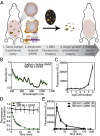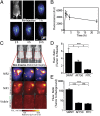Deep, noninvasive imaging and surgical guidance of submillimeter tumors using targeted M13-stabilized single-walled carbon nanotubes
- PMID: 25214538
- PMCID: PMC4183329
- DOI: 10.1073/pnas.1400821111
Deep, noninvasive imaging and surgical guidance of submillimeter tumors using targeted M13-stabilized single-walled carbon nanotubes
Abstract
Highly sensitive detection of small, deep tumors for early diagnosis and surgical interventions remains a challenge for conventional imaging modalities. Second-window near-infrared light (NIR2, 950-1,400 nm) is promising for in vivo fluorescence imaging due to deep tissue penetration and low tissue autofluorescence. With their intrinsic fluorescence in the NIR2 regime and lack of photobleaching, single-walled carbon nanotubes (SWNTs) are potentially attractive contrast agents to detect tumors. Here, targeted M13 virus-stabilized SWNTs are used to visualize deep, disseminated tumors in vivo. This targeted nanoprobe, which uses M13 to stably display both tumor-targeting peptides and an SWNT imaging probe, demonstrates excellent tumor-to-background uptake and exhibits higher signal-to-noise performance compared with visible and near-infrared (NIR1) dyes for delineating tumor nodules. Detection and excision of tumors by a gynecological surgeon improved with SWNT image guidance and led to the identification of submillimeter tumors. Collectively, these findings demonstrate the promise of targeted SWNT nanoprobes for noninvasive disease monitoring and guided surgery.
Keywords: M13 bacteriophage; cancer imaging; fluorescence-guided surgery.
Conflict of interest statement
The authors declare no conflict of interest.
Figures




References
-
- van Dam GM, et al. Intraoperative tumor-specific fluorescence imaging in ovarian cancer by folate receptor-α targeting: First in-human results. Nat Med. 2011;17(10):1315–1319. - PubMed
-
- Lim YT, et al. Selection of quantum dot wavelengths for biomedical assays and imaging. Mol Imaging. 2003;2(1):50–64. - PubMed
Publication types
MeSH terms
Substances
Grants and funding
LinkOut - more resources
Full Text Sources
Other Literature Sources

